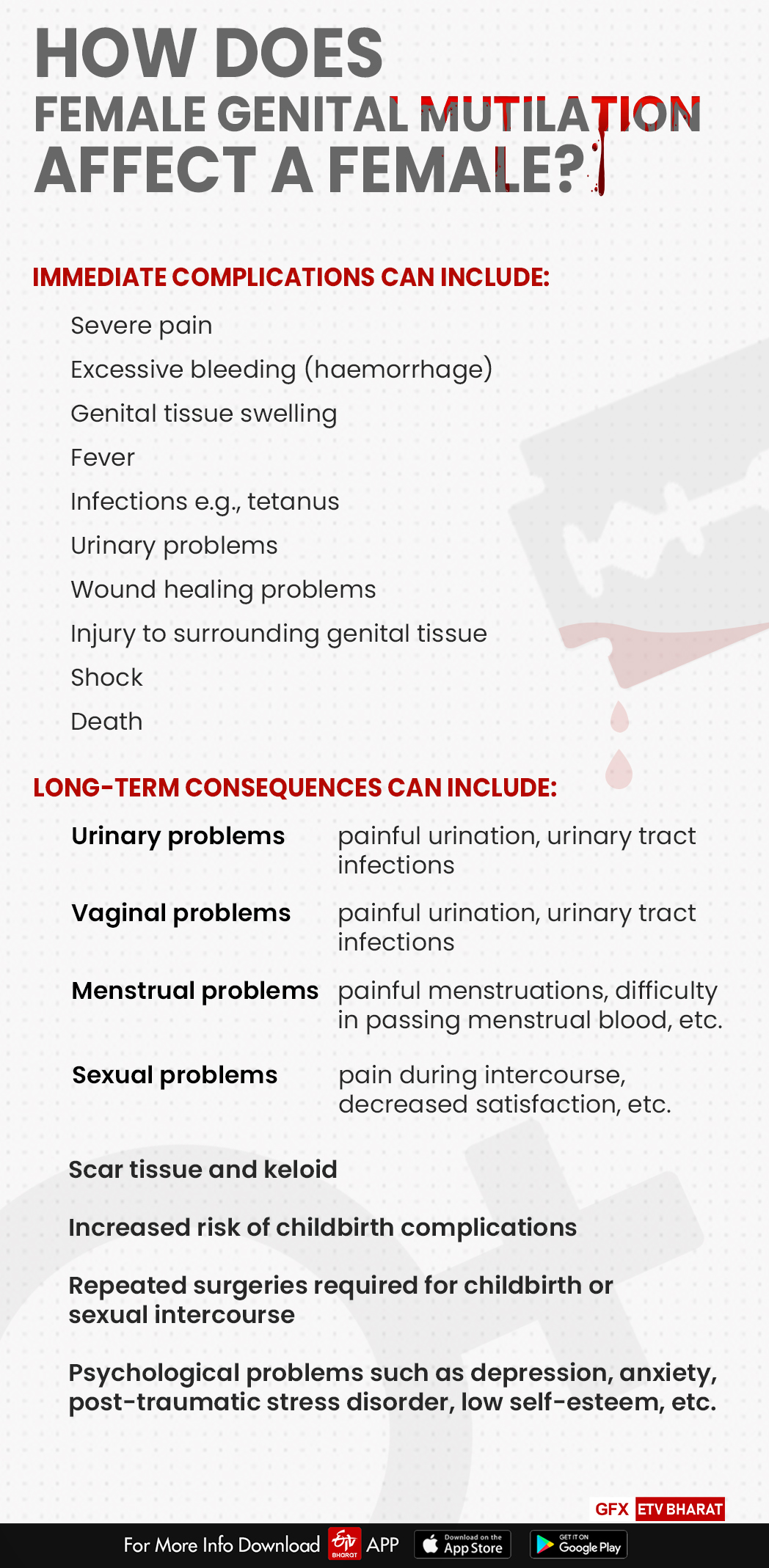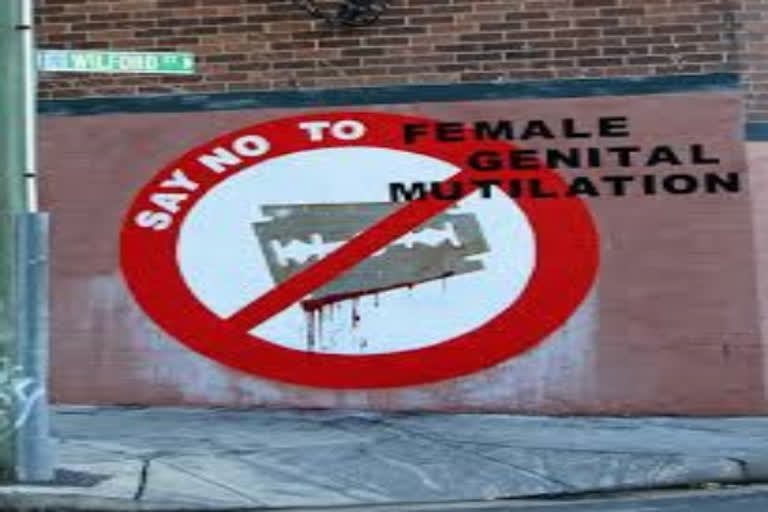Hyderabad: As the world observes International Day of Zero Tolerance for Female Genital Mutilation (FGM) on February 6, it calls for for a reflection on the state of the practice in India and the world. As many as 4.1 million girls around the world are at risk of undergoing female genital mutilation in 2020 alone, as per a United Nation's (UN) report.
In a bid to mobilise youth around the elimination of harmful practices such as FGM, the International Day this year is being celebrated around the theme: "Unleashing Youth Power: One decade of accelerating actions for zero female genital mutilation."
The UN aims to eradicate the centuries-old practice by 2030.
What is FGM?
Female genital mutilation (FGM) comprises all procedures that involve altering or injuring the female genitalia for non-medical reasons and is recognized internationally as a violation of the human rights, the health and the integrity of girls and women.
Although primarily concentrated in 30 countries in Africa and the Middle East, female genital mutilation is a universal problem and is also practised in some countries in Asia and Latin America.
It also continues to persist among immigrant populations living in Western Europe, North America, Australia and New Zealand.
FGM in India
Female Genital Mutilation or Cutting (FGM/C) as it is practised in India is known as “khatna” or “khafz”, and involves the removal of the clitoral hood or the clitoris.
This practice is common among the Bohra community, whose members live in Gujarat, Maharashtra, Rajasthan, Madhya Pradesh and Kerala. The Bohra community is estimated to be one million strong in India; many also live outside India.
While the practice is well-documented around the world, in India the veil of secrecy around the practice has meant there is no official data on its prevalence.
In 2018, a study published by WeSpeakOut, a survivor-led movement, revealed that 75% of daughters (aged seven years and above) of all respondents in the sample, from the Bohra community, were subjected to FGM/C. Approximately 33% of the women surveyed reported that FGM/C had negatively affected their sexual life. Many said that they experienced painful urination, physical discomfort, difficulty walking, and bleeding immediately following the procedure. The women also reported long-lasting psychological harm resulting from their experiences.
India is now becoming a hub for FGM because of the recent legal action taken against FGM among Bohras in Australia and the USA. In 2016, Australia sentenced three Dawoodi Bohras to 15 months in jail under the country's female genital mutilation law.
How does it affect a female?
FGM has no health benefits, and it harms girls and women in many ways. It involves removing and damaging healthy and normal female genital tissue and interferes with the natural functions of girls' and women's bodies. Generally speaking, risks increase with increasing severity of the procedure.

Immediate complications can include:
- Severe pain
- Excessive bleeding (haemorrhage)
- Genital tissue swelling
- Fever
- Infections e.g., tetanus
- Urinary problems
- Wound healing problems
- Injury to surrounding genital tissue
- Shock
- Death
Long-term consequences can include:
- Urinary problems (painful urination, urinary tract infections)
- Vaginal problems (discharge, itching, bacterial vaginosis and other infections)
- Menstrual problems (painful menstruations, difficulty in passing menstrual blood, etc.)
- Scar tissue and keloid
- Sexual problems (pain during intercourse, decreased satisfaction, etc.)
- Increased risk of childbirth complications such as difficult delivery, excessive bleeding, caesarean section, need to resuscitate the baby, etc., and newborn deaths
- Repeated surgeries for childbirth or sexual intercourse
- Psychological problems such as depression, anxiety, post-traumatic stress disorder, low self-esteem, etc.
Beliefs and superstitions behind the practice
- To 'save' a girl for marriage
- A perceived need to control female sexuality
- Family honour
- social expectation
- Higher dowries for girls and women seen as more 'chaste'
Some facts and figures
In 2020 alone, there are 4.1 million girls around the world are at risk of undergoing female genital mutilation.
According to UNFPA, the cost of preventing female genital mutilation is $95 per girl today.
As many as 30 countries, where female genital mutilation is prevalent, are experiencing high population growth, with at least 30 per cent of girls undergoing female population under the age of 15.
Young people aged 15 to 19 in countries where female genital mutilation is prevalent are less supportive of continuing the practice than are adults aged 45 to 49.
In many countries where female genital mutilation is prevalent, young girls have a dramatically increased chance of growing up without the risk of undergoing this harmful practice compared to their mothers and grandmothers.
If current trends continue, 15 million additional girls between ages 15 and 19 will be subjected to it by 2030.
What has been done so far?
In 2012, the UN General Assembly designated February 6th as the International Day of Zero Tolerance for Female Genital Mutilation, with the aim to amplify and direct the efforts on the elimination of this practice.
Significant progress has been made recently in bringing the issue of FGM/Khafz to public attention in India.
Minister for Women and Child Development Maneka Gandhi has publicly stated that FGM/Khafz is a crime under existing laws, and has asked the religious head of the Bohra community to take measures to put an end to the practice.
In an ongoing case at the Supreme Court, the judges on the bench have made remarks stating that FGM/Khafz prima facie appears to be a violation of the right to privacy guaranteed by the constitution. The court also notes that there seems to be no scientific or medical basis for the practice of FGM/Khafz, which is likely to cause a significant amount of trauma, pain and bleeding.
Meanwhile, 17 Bohra women have launched a petition, which has more than 100,000 signatories so far, calling for a ban in India.
What needs to be done?
- Government of India and judiciary need to acknowledge the fact that FGM exists in India
- Legislation needs to be framed to ban FGM
- Public discourse around the issue must be encouraged
- Educate girls on rights to their body
- Community intervention.



